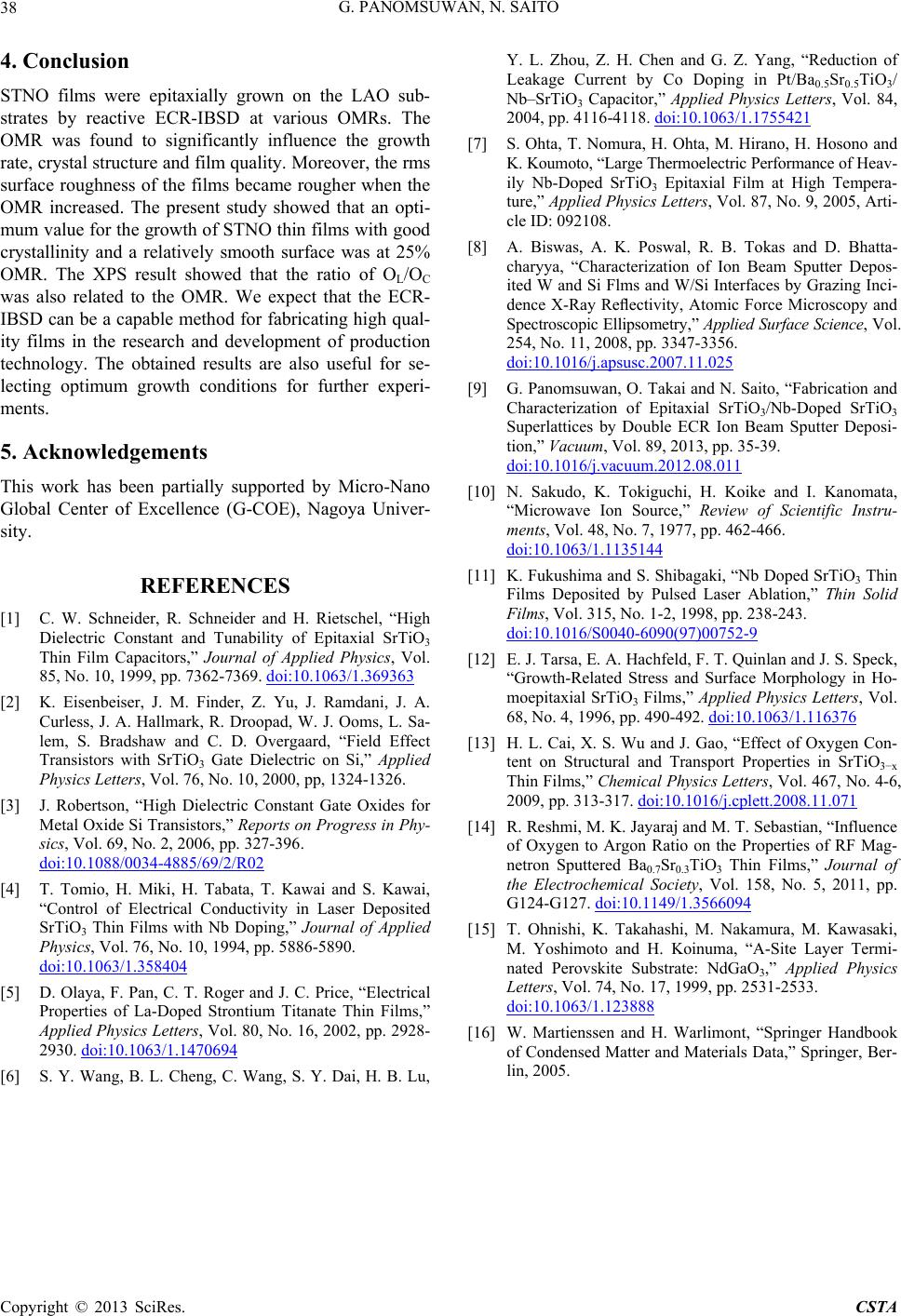
G. PANOMSUWAN, N. SAITO
Copyright © 2013 SciRes. CSTA
38
epitaxially grown on the LAO sub-
e ECR-IBSD at various OMRs. The
owledgements
supported by Micro-Nano
(G-COE), Nagoya Un
REFERENCES
[1] C. W. Schnei. Rietschel, “High
Dielectric Cof Epitaxial SrTiO3
4. Conclusion
STNO films were
strates by reactiv
OMR was found to significantly influence the growth
rate, crystal structure and film quality. Moreover, the rms
surface roughness of the films became rougher when the
OMR increased. The present study showed that an opti-
mum value for the growth of STNO thin films with good
crystallinity and a relatively smooth surface was at 25%
OMR. The XPS result showed that the ratio of OL/OC
was also related to the OMR. We expect that the ECR-
IBSD can be a capable method for fabricating high qual-
ity films in the research and development of production
technology. The obtained results are also useful for se-
lecting optimum growth conditions for further experi-
ments.
5. Ackn
This work has been partially
Global Center of Excellence
iver-
sity.
der, R. Schneider and H
nstant and Tunability o
Thin Film Capacitors,” Journal of Applied Physics, Vol.
85, No. 10, 1999, pp. 7362-7369. doi:10.1063/1.369363
[2] K. Eisenbeiser, J. M. Finder, Z. Yu, J. Ramdani, J. A.
Curless, J. A. Hallmark, R. Droopad, W. J. Ooms, L. Sa-
-
lem, S. Bradshaw and C. D. Overgaard, “Field Effect
Transistors with SrTiO3 Gate Dielectric on Si,” Applied
Physics Letters, Vol. 76, No. 10, 2000, pp, 1324-1326.
[3] J. Robertson, “High Dielectric Constant Gate Oxides for
Metal Oxide Si Transistors,” Reports on Progress in Phy
sics, Vol. 69, No. 2, 2006, pp. 327-396.
doi:10.1088/0034-4885/69/2/R02
[4] T. Tomio, H. Miki, H. Tabata, T. Kawa
“Control of Electrical Conductivi
i and S. Kawai,
ty in Laser Deposited
SrTiO3 Thin Films with Nb Doping,” Journal of Applied
Physics, Vol. 76, No. 10, 1994, pp. 5886-5890.
doi:10.1063/1.358404
[5] D. Olaya, F. Pan, C. T. Roger and J. C. Price, “E
Properties of La-Doped
lectrica
Strontium Titanate Thin Films,”
l
Applied Physics Letters, Vol. 80, No. 16, 2002, pp. 2928-
2930. doi:10.1063/1.1470694
[6] S. Y. Wang, B. L. Cheng, C. Wang, S. Y. Dai, H. B. Lu,
Y. L. Zhou, Z. H. Chen and G. Z. Yang, “Reduction of
Leakage Current by Co Doping in Pt/Ba0.5Sr0.5TiO3/
Nb–SrTiO3 Capacitor,” Applied Physics Letters, Vol. 84,
2004, pp. 4116-4118. doi:10.1063/1.1755421
[7] S. Ohta, T. Nomura, H. Ohta, M. Hirano, H. Hosono and
oswal, R. B. Tokas and D. Bhatta-
K. Koumoto, “Large Thermoelectric Performance of Heav-
ily Nb-Doped SrTiO3 Epitaxial Film at High Tempera-
ture,” Applied Physics Letters, Vol. 87, No. 9, 2005, Arti-
cle ID: 092108.
[8] A. Biswas, A. K. P
charyya, “Characterization of Ion Beam Sputter Depos-
ited W and Si Flms and W/Si Interfaces by Grazing Inci-
dence X-Ray Reflectivity, Atomic Force Microscopy and
Spectroscopic Ellipsometry,” Applied Surface Science, Vol.
254, No. 11, 2008, pp. 3347-3356.
doi:10.1016/j.apsusc.2007.11.025
[9] G. Panomsuwan, O. Takai and N. Saito, “Fabrication and
Characterization of Epitaxial SrTiO3/Nb-Doped SrTiO3
Superlattices by Double ECR Ion Beam Sputter Deposi-
tion,” Vacuum, Vol. 89, 2013, pp. 35-39.
doi:10.1016/j.vacuum.2012.08.011
[10] N. Sakudo, K. Tokiguchi, H. Koike and I. Kanomata,
“Microwave Ion Source,” Review of Scientific Instru-
ments, Vol. 48, No. 7, 1977, pp. 462-466.
doi:10.1063/1.1135144
[11] K. Fukushima and S. Shibagaki, “Nb Doped SrTiO Thin
3
Films Deposited by Pulsed Laser Ablation,” Thin Solid
Films, Vol. 315, No. 1-2, 1998, pp. 238-243.
doi:10.1016/S0040-6090(97)00752-9
[12] E. J. Tarsa, E. A. Hachfeld, F. T. Quinlan and J. S. Speck,
“Growth-Related Stress and Surface Morphology in Ho-
moepitaxial SrTiO3 Films,” Applied Physics Letters, Vol.
68, No. 4, 1996, pp. 490-492. doi:10.1063/1.116376
[13] H. L. Cai, X. S. Wu and J. Gao, “Effect of Oxygen Con-
tent on Structural and Transport Properties in SrTiO3−x
Thin Films,” Chemical Physics Letters, Vol. 467, No. 4-6,
2009, pp. 313-317. doi:10.1016/j.cplett.2008.11.071
[14] R. Reshmi, M. K. Jayaraj and M. T. Sebastian, “Influence
of Oxygen to Argon Ratio on the Properties of RF Mag-
netron Sputtered Ba0.7Sr0.3TiO3 Thin Films,” Journal of
the Electrochemical Society, Vol. 158, No. 5, 2011, pp.
G124-G127. doi:10.1149/1.3566094
[15] T. Ohnishi, K. Takahashi, M. Nakamura, M. Kawasaki,
M. Yoshimoto and H. Koinuma, “A-Site Layer Termi-
nated Perovskite Substrate: NdGaO3,” Applied Physics
Letters, Vol. 74, No. 17, 1999, pp. 2531-2533.
doi:10.1063/1.123888
[16] W. Martienssen and H. Warlimont, “Springer Handbook
of Condensed Matter and Materials Data,” Springer, Ber-
lin, 2005.